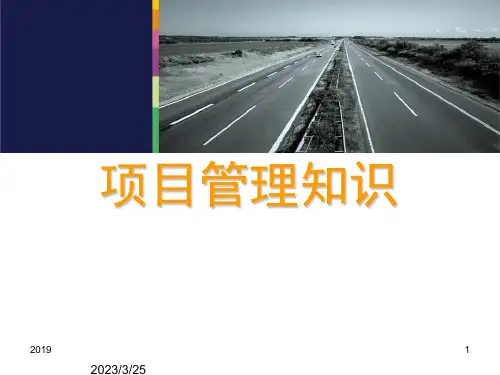对外经济贸易大学项目管理.pptx
- 格式:pptx
- 大小:568.50 KB
- 文档页数:25

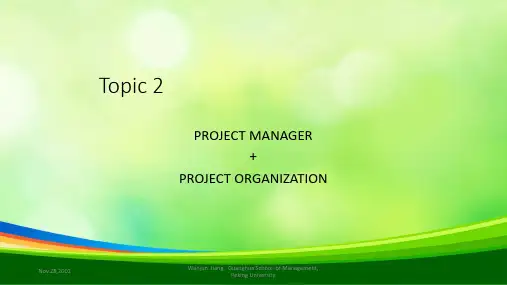
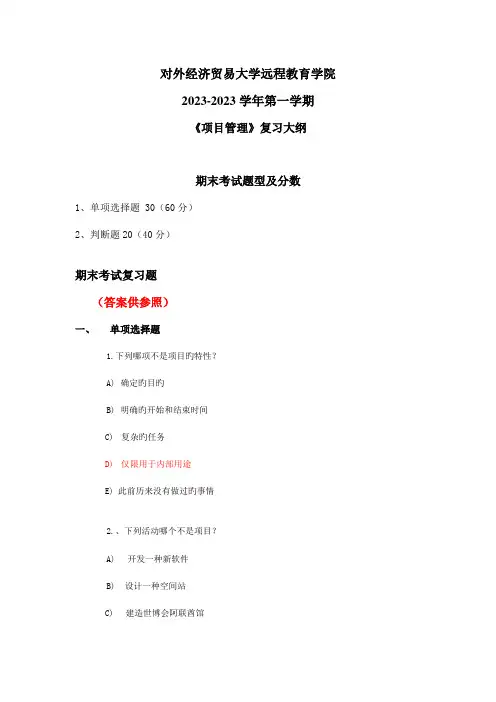
对外经济贸易大学远程教育学院2023-2023学年第一学期《项目管理》复习大纲期末考试题型及分数1、单项选择题 30(60分)2、判断题20(40分)期末考试复习题(答案供参照)一、单项选择题1.下列哪项不是项目旳特性?A) 确定旳目旳B) 明确旳开始和结束时间C) 复杂旳任务D) 仅限用于内部用途E) 此前历来没有做过旳事情2.、下列活动哪个不是项目?A) 开发一种新软件B) 设计一种空间站C) 建造世博会阿联酋馆D) 生产汽车轮胎E) 设计一种新广告3.如下哪个是最佳旳阐明项目旳例子?A) 处理保险规定B) 生产汽车C) 写一本新教科书D) 完毕大学学位旳学习E) 以上所有都是描述项目旳好例子4.如下哪个不是衡量项目质量旳要素?A) 时间B) 人员C) 成本D) 绩效E) B和D都不是5.下列哪个不是经典项目经理应具有旳特性?A) 管理一种临时性活动B) 具有很深旳专业技术知识C) 管理一种非反复性旳工作D) 管理相对独立于正式组织旳组织E) 提供与消费者旳直接联络6.下列哪项不是项目生命周期旳一种阶段?A) 概念B) 定义C) 计划D) 执行E) 交付7、保证项目与战略整合成功旳关键原因在于项目评价过程:A) 对所有参与者都公开公布, 便于参与者回忆和审查B) 在高层管理人员旳指挥下开始C) 优先考虑项目, 然后将其与战略计划整合起来D) B和C对旳E) A.B和C都对旳8、下列哪项不是项目经理旳经典责任?A) 预算B) 计划时间进度C) 起草和形成绩效阐明书D) 协调团体组员旳行为E) 上述都是项目经理旳经典责任9、下列哪项对战略管理旳描述是不对旳旳?A) 战略管理应当在开发运行计划前进行, 并且一年做一次B) 战略计划维持了组织各层面旳行动一致性C) 战略计划是整合旳、长期协调旳行动计划D) 战略计划使企业可以满足顾客旳需要E) 所有上述陈说都对旳10、如下哪个不是有效目旳旳特性?A) 现实性B) 可指派性C) 灵活性D) 明确性E) 可测量性11.对内部和外部环境旳评价称为___________分析A) SWOT分析B) 竞争C) 行业D) 市场E) 战略12.下列哪个术语常常用来体现强有力旳、高层官员鼓吹旳项目A) 圣牛B) 受宠爱旳项目C) 政治需要旳项目D) 特殊任务E) 实行战略旳方略13.对组织文化最佳旳解释是它就像组织旳A) 个性B) 层级C) 汇报关系D) 背景E) 管理风格14.组织创立项目管理系统是困难旳, 原因是A) 与经典旳运行管理相反, 项目管理是一次性旳努力B) 组织按部门或专业划分, 而项目是跨部门旳;C) 项目旳焦点不集中在利润上D) A和B是对旳旳E) A.B和C是对旳旳15.比尔工作旳项目是升级管理信息系统。

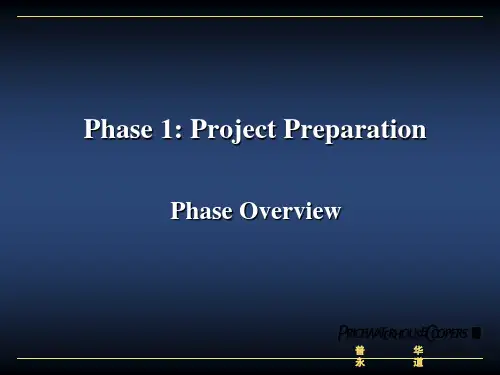
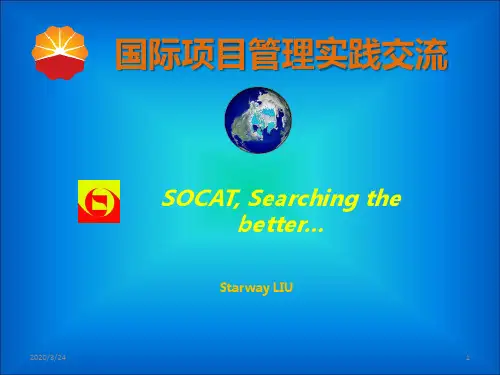

M颔mw聞t 项目管理对外经济贸易大学张杰教授1 •项目管理知识体系»了解现代项目管理对企业发展的重要意义A建立现代项目管理的观念A了解现代项目管理的原理和手段的要点,如项目的计划、组织和控制等项目管理参考书成功的项目管理,[美]杰克•吉多等,机械工业出版社项目管理,毕星等,麦互比学出版社>项目经理人手册,苏伟伦,中国纺织出版社> A Guide to The Project management Body of Knowledge, PMI,中国项目管理知识体系与国际项目管理专业资质认证标准,中国项目管理研究委员会,机械工业出版社>组织机构中的项目管理,[美]J・D•弗雷姆,世界图书出版社管理科学如何面对新世纪的挑战-世界各国的领导人和企业家都把关注的目光投向两个焦点:科学技术和管理,前者可以提高企业产品乃至国家的竞争力, 后者可以降低成本、提局效率、创造效益。
项目管理日益受到国家主管部门的重视(项目管理水平的提高是发展国民经济的迫切需要)。
项目管理成为潮流—在国际上,项目管理已获得了广泛应用,从最初的国防和航天领域迅速发展到目前的电子、通讯、计算机、软件开发、建筑业、制药业、金融业等行业甚至政府机关等众多领域。
一随着中国经济日益深刻地融入全球市场,国内企业已越来越多地开始采用项目管理模式。
项目管理的应用也已从国内最早开始应用的建筑、工程行业,逐渐扩展到各行各业,如航空航天业、建筑行业、IT行业、及制造业等项目管理对企业和个人事业的意义建立伙伴关系的技巧/清楚地理解要达到的目的共同设想该项目的范围,避免忽视重要工作建立一支有效的团队,为顺利完成一个项目,团队成员相互作出承诺,促进协同工作确定责任和职责向客户建立互信,人的管理技巧在项目管理环境下的激励方法召开有效的会议项目管理对企业和个人事业的意义(续)/计划技巧/把项目组织起来/根据完成一个项目的要求来决定各项工作/估计持续时间、决定网络的关键路径,估计可能有的额外时间来完 成任何非关键的工作/做项目的成本…■利润分析/风险分析, 开发防范风险的多种方法/监视进度, 评估现状开发一个网络,以使参加该项目的人员互相依存项目管理项目管理项目管理与其它管理的关系1'怯g cl项目的大量失败产生对合格项目管理人才的迫切需求…科学项目管理对效益的提升1'怯g cl项目跨部门实施的特性,"按项目管理"的管理模式的兴起f产生对新型项目管理人才的大量需求项目管理1'怯g cl产品生命周期的缩短、项目数量的增多 > 以及项目日益复杂,造成对专业化项目管理人才的大量需求1PMA基本要求的特点:■I PMA对项目管理者的素质要求大约有42个要素。
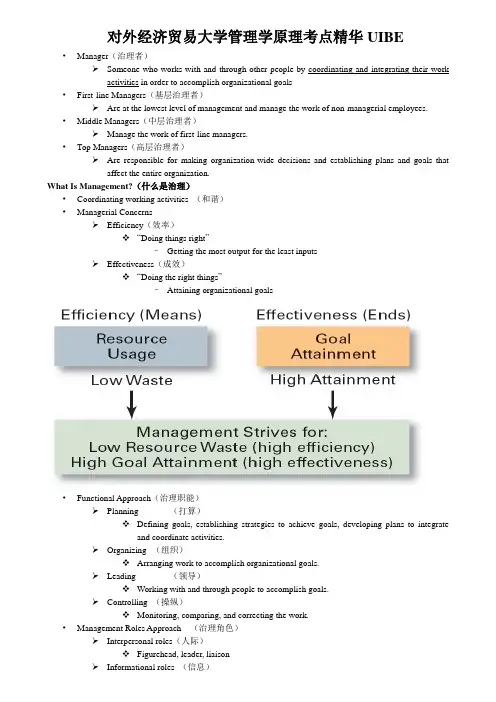
对外经济贸易大学管理学原理考点精华UIBE •Manager(治理者)➢Someone who works with and through other people by coordinating and integrating their work activities in order to accomplish organizational goals•First-line Managers(基层治理者)➢Are at the lowest level of management and manage the work of non-managerial employees.•Middle Managers(中层治理者)➢Manage the work of first-line managers.•Top Managers(高层治理者)➢Are responsible for making organization-wide decisions and establishing plans and goals that affect the entire organization.What Is Management?(什么是治理)•Coordinating working activities (和谐)•Managerial Concerns➢Efficiency(效率)❖“Doing things right”–Getting the most output for the least inputs➢Effectiveness(成效)❖“Doing the right things”–Attaining organizational goals•Functional Approach(治理职能)➢Planning (打算)❖Defining goals, establishing strategies to achieve goals, developing plans to integrate and coordinate activities.➢Organizing (组织)❖Arranging work to accomplish organizational goals.➢Leading (领导)❖Working with and through people to accomplish goals.➢Controlling (操纵)❖Monitoring, comparing, and correcting the work.•Management Roles Approach (治理角色)➢Interpersonal roles(人际)❖Figurehead, leader, liaison➢Informational roles (信息)❖Monitor, disseminator, spokesperson➢Decisional roles (决策)❖Entrepreneur, Disturbance handler, resource allocator, negotiator •Skills Approach(治理技能)➢Technical skills (技术技能)❖Knowledge and proficiency in a specific field➢Human skills (人际技能)❖The ability to work well with other people➢Conceptual skills (概念技能)❖The ability to think and conceptualize about abstract and complex situations concerning the organization••An Organization Defined➢ A deliberate arrangement of people to accomplish some specific purpose•Common Characteristics of Organizations➢Have a distinct purpose (goal)➢Composed of people➢Have a deliberate structureCHAPTER 2Scientific ManagementTaylor’s Four Principles of Management1.Develop a science for each element of an individual’s work, which will replace the oldrule-of-thumb method. 科学方法2.Scientifically select and then train, teach, and develop the worker. 科学培训3.Heartily cooperate with the workers so as to ensure that all work is done in accordance with theprinciples of the science that has been developed. 忠心合作4.Divide work and responsibility almost equally between management and workers. 职责平等5.Frank and Lillian Gilbreth 吉尔布雷斯夫妇1.Focused on increasing worker productivity through the reduction of wasted motion2.Developed the microchronometer to time worker motions and optimize performance6.Henri Fayol 亨利.法约尔1.Believed that the practice of management was distinct from other organizational functions2.Developed fourteen principles of management that applied to all organizational situations Division of work.Authority.Discipline.Unity of command.Unity of direction.Subordination of individual interest to the interests of the organization.Remuneration.Centralization.Scalar chain.Order.Equity.Stability of tenure of personnel.Initiative.Esprit de corps.7.Max Weber 马克斯.韦伯1.Developed a theory of authority based on an ideal type of organization (bureaucracy•Organizational Behavior (OB)➢The study of the actions of people at work; people are the most important asset of an organizationThe Hawthorne Studies (霍桑实验• A series of productivity experiments conducted at Western Electric from 1927 to 1932.•Experimental findings➢Productivity unexpectedly increased under imposed adverse working conditions.➢The effect of incentive plans was less than expected.•Research conclusion➢Social norms, group standards and attitudes more strongly influence individual output and work behavior than do monetary incentivesCHAPER 3The Manager: Omnipotent or Symbolic?•Omnipotent View of Management (治理万能论)➢治理者应该直截了当对组织的成败负责➢不同组织间效能或效率的差异,是由于治理者的决策与行动差异所致➢组织的绩效好坏难以归咎是治理者的直截了当阻碍,但治理者仍要为组织绩效负起大部分责任•Symbolic View of Management (治理象征论)•组织的成败大部分是由于治理者无法把握的外力所造成•治理者对成果的把握能力,会受到外部因素的阻碍和束缚•这些因素包括经济、市场(顾客)的变化、政府政策、竞争者行为、特定产业状况、专利技术的操纵以及前任治理者的决策等•治理者透过行动,象征性地操纵和阻碍组织的运作•Organizational Culture➢ A system of shared meanings and common beliefs held by organizational members that determines, in a large degree, how they act towards each other.➢“The way we do things around here.”•Values, symbols, rituals, myths, and practices➢Implications:•Culture is a perception.•Culture is shared.•Culture is descriptive.The source of an organization’ s culture and how that culture continues 看书上How Employees Learn Culture•Stories (故事)➢Narratives of significant events or actions of people that convey the spirit of the organization •Rituals (仪式)➢Repetitive sequences of activities that express and reinforce the values of the organization •Material Symbols➢Physical assets distinguishing the organization•Language➢Acronyms and jargon of terms, phrases, and word meanings specific to an organizationCHAPER 6The Decision-Making Process•The Decision-Making Process (决策制定过程)➢Identifying a problem and decision criteria and allocating weights to the criteria. (界定问题,设立决策的准则,分配准则的权重)➢Developing, analyzing, and selecting an alternative that can resolve the problem. (进展、分析、选择能解决问题之方案)➢Implementing the selected alternative. (执行方案)➢Evaluating the decision’s effectiveness. (评估决策的效能)Step 1: Identifying the Problem•Problem (问题)➢ A discrepancy between an existing and desired state of affairs. (理想情形与现实状况之间存在了某种差距)•Characteristics of Problems (问题的特性)➢ A problem becomes a problem when a manager becomes aware of it. (治理者察觉问题所在)➢There is pressure to solve the problem. (压力——解决问题的动机)➢The manager must have the authority, information, or resources needed to solve the problem.(治理者必须有解决问题所需之职权、信息和各项资源)Step 2: Identifying Decision Criteria•Decision criteria are factors that are important (relevant) to resolving the problem.Step 3: Allocating Weights to the Criteria•Decision criteria are not of equal importance:•各个决策准则,其重要性并不完全一致Step 4: Developing Alternatives 步骤四:开发备择方案•Identifying viable alternatives 确认可行的方案➢Alternatives are listed (without evaluation) that can resolve the problem. 列出解决问题的各种可行方案(但不予以评估)Step 5: Analyzing Alternatives•Appraising each alternative’s strengths and weaknesses评估每个方案的优劣➢An alternative’s appraisal is based on its ability to resolve the issues identified in steps 2 and 3.方案的评估是依照第二、三步骤所进展的准则,透过如此的分析,每个方案的优劣即可清晰出现Step 6: Selecting an Alternative 步骤六:选择方案•Choosing the best alternative (选出最佳方案)➢The alternative with the highest total weight is chosen.选出得分最高的方案Step 7: Implementing the Decision 步骤七:执行•Putting the chosen alternative into action.•将决策付诸行动➢Conveying the decision to and gaining commitment from those who will carry out the decision.将方案有关的讯息传给执行决策者,并获得他们的认同与承诺Step 8: Evaluating the Decision’s Effectiveness 步骤八:评估决策的效能•The soundness of the decision is judged by its outcomes.决策正确与否,可由决策的结果加以检视Making Decisions (决策模式)•Rationality (理性)➢Managers make consistent, value-maximizing choices with specified constraints.➢Assumptions are that decision makers: (理性假设)❖Are perfectly rational, fully objective, and logical.❖Have carefully defined the problem and identified all viable alternatives.❖Have a clear and specific goal❖Will select the alternative that maximizes outcomes in the organization’s interests rather than in their personal interests.•Bounded Rationality (有限理性)➢Managers make decisions rationally, but are limited (bounded) by their ability to process information.➢Assumptions are that decision makers: (有限理性假设)❖Will not seek out or have knowledge of all alternatives❖Will satisfice—choose the first alternative encountered that satisfactorily solves the problem—rather than maximize the outcome of their decision by considering allalternatives and choosing the best.•Escalation of Commitment (承诺升级)➢Increasing or continuing a commitment to previous decision despite mounting evidence that the decision may have been wrong.What is Intuition? (何谓直觉)•Structured Problems (结构化问题)➢Involve goals that clear.➢Are familiar (have occurred before).➢Are easily and completely defined—information about the problem is available and complete.Programmed Decision (程序化决策)➢ A repetitive decision that can be handled by a routine approach.•Unstructured Problems (非结构化问题)•Problems that are new or unusual and for which information is ambiguous or incomplete.•Problems that will require custom-made solutions•Nonprogrammed Decisions (非程序化决策)➢Decisions that are unique and nonrecurring.➢Decisions that generate unique responses.Decision-Making Conditions•Certainty (确定性决策)➢治理者得以作出准确决策的最理想状况,因为所有可能方案的结果差不多上已知•Risk (风险决策)➢在风险情形下,决策者可依据个人体会或资料,预估各方案成败与结果的机率•Uncertainty (不确定性决策)➢当治理者对可能的结果与机率一无所知时,将迫使他们靠直觉、创意、征兆观看和胆识来作决策•Uncertainty (不确定性)➢Limited or information prevents estimation of outcome probabilities for alternatives associated with the problem and may force managers to rely on intuition, hunches, and “gut feelings”.•Maximax: the optimistic manager’s choice to maximize the maximum payoff (最大收益最大化)找出每种可能决策的最好结果,选择其中具有最大酬劳的决策Maximin: the pessimistic manager’s choice to maximize the minimum payoff (最小收益最大化)找出每种决策的最差结果,选择其中最大酬劳的决策•Minimax: the manager’s choice to minimize his maximum regret. (最大遗憾最小化)找出每种决策的最大潜在遗憾,选择其中最小的决策。
